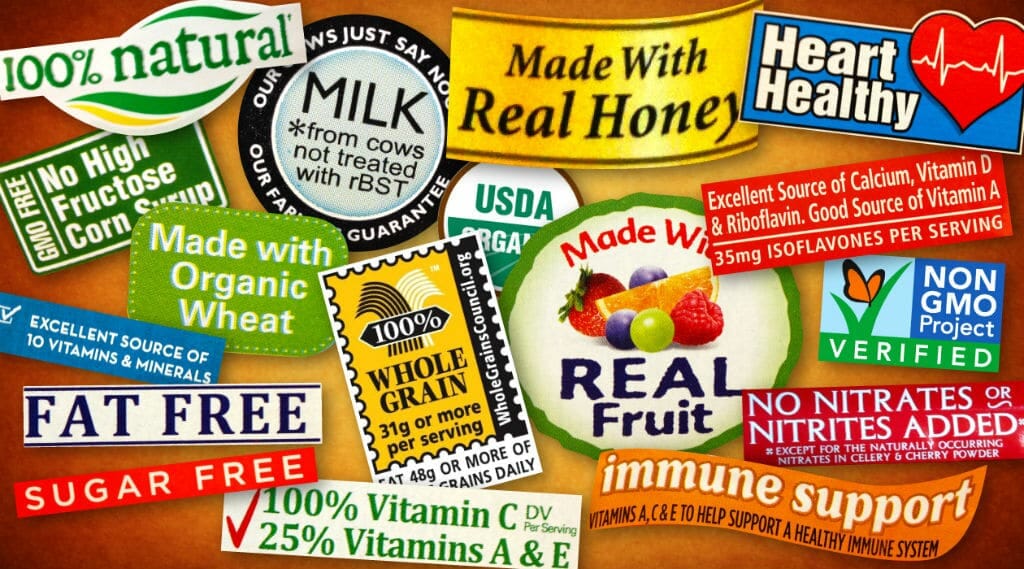When you buy an electronic appliance, it comes with an instruction manual that explains its parts and their functions. The same goes for toys, books, etc. that all come with a table of contents or a manual. Food labels are a lot like that. They are meant to tell us about the nutritional facts, the health standards, ingredients, etc. that go inside the package. The problem is, while they are meant to be informational, they are almost always confusing and at times misleading too. Even the most educated of us shoppers can get confused when it comes to choosing between hydrogenated or partially hydrogenated oils, multigrain or whole grain, and a lot of other such jargon.
Are you falling for fancy claims on food packages?
Let’s take a look at 5 most common confusing food labels you are likely to encounter on a regular supermarket trip and decode what they really mean.
#1 Hydrogenated oils vs. Partially hydrogenated oils (PHOs)
What’s healthier: none actually though PHOs cause a lot more damage
Found in: Both the varieties of oils are commonly found in cookies, crackers, candies, fried foods, pastries, etc.
Hydrogenated oils contain saturated fats while PHOs are rich in trans fats. While none is particlularly healthy, trans fats cause more harm as they elevate the levels of dangerous LDL cholesterol and lower HDL cholesterol (the healthier kind). On the other hand, hydrogenated fats have no negative effect on healthy HDLs while they may still contributing to increasing LDL levels though.
#2 Low fat or Reduced fat or Less Fat or Fat Free
Low fat is straightforward – it implies that a serving of that product contains 3g of fat or less, and 30% or less of total calories. Reduced fat and Less Fat, on the other hand, are a bit confusing. Reduced Fat means that the food product contains 50% (or less) of the fat found in the regular version per serving, while Less Fat implies 25% or less fat than the comparison food. When you see Fat Free, it means that the product has less than 0.5 grams of fat per serving, and contains no added fat or oil.
#3 “Multigrain” or “whole grain”
What’s healthier: Whole-grain
Gone are the days when breakfast meant putting together a plate of bread and butter with some milk to go along. Now we have a plethora of bread varieties to choose from – white, brown, multigrain, whole grain, whole wheat, and more! Coming to the confusing part, whole grain implies that all parts of the grain kernel — the bran, germ and endosperm — are used in the food product, making it a rich source of nutrients, minerals, fiber, and other natural plant compounds. The label Multi-grain, on the other hand, simply means that more than one type of grain makes up that food product. The same goes for ‘five-grains’ or seven-grains’ – newer terms being seen on food labels nowadays.
#4 “Sugar-free” or “no added sugar”
What’s healthier: Sugar-free
With the WHO reporting an increase in the global prevalence of Diabetes from 4.7% to 8.5%, consumers are giving utmost attention to the word ‘sugar’ on food labels. While “sugar-free” means that the food product packs in less than half a gram of sugar per serving, a “no sugars added” label simply means that no sugar was added in processing. However, to compensate for a lack of sweetness and to add to the taste, some food manufacturers may add more fat or protein to the product, which in turn increases calories. Sugar alcohols are also a common additive in these foods and they are known to cause gastrointestinal discomfort.
#5 “Excellent source of fiber” or “fortified with extra fiber”
What’s healthier: Excellent source of fiber
An excellent source of fiber or high-fiber food is one that contains at least five grams of fiber per serving i.e. 20%of the daily recommended intake for a healthy adult. Moreover, natural fiber found in food is a mix of types, with all having different health benefits such as bowel health, blood sugar maintenance, cholesterol control, etc. The label ‘made with extra fiber’ implies that the product should supply at least 10 % more of the daily recommended intake per serving in comparison to a similar food. What still makes these ‘extra fiber’ products less healthier is that the added fiber is usually just one type, such as cellulose (from wood pulp), inulin (chicory extract), oligosaccharides, or fructans. It fails to provide the multifarious benefits that natural fiber gives.
Reading between the lines
With 75% of customers across the world reporting confusion understanding food labels, the food industry clearly needs an overhaul of labelling standards. As for consumers, while everyone can not be a nutritionist to know the exact truth about labels, we can certainly arm ourselves with a few basic facts that will go a long way in helping us make healthier choices. It’s time we steer clear of the marketing spin and ditch those fancy claims for some real, earthy goodness!
